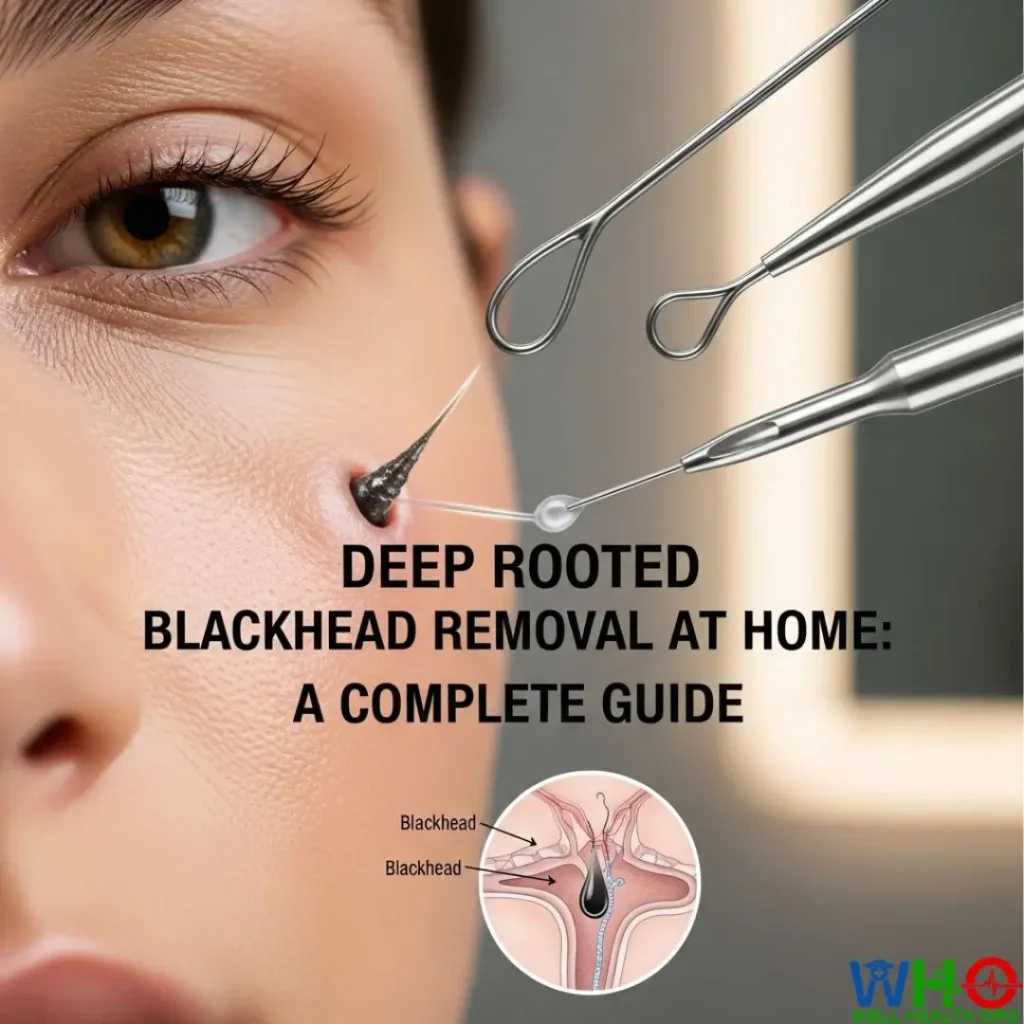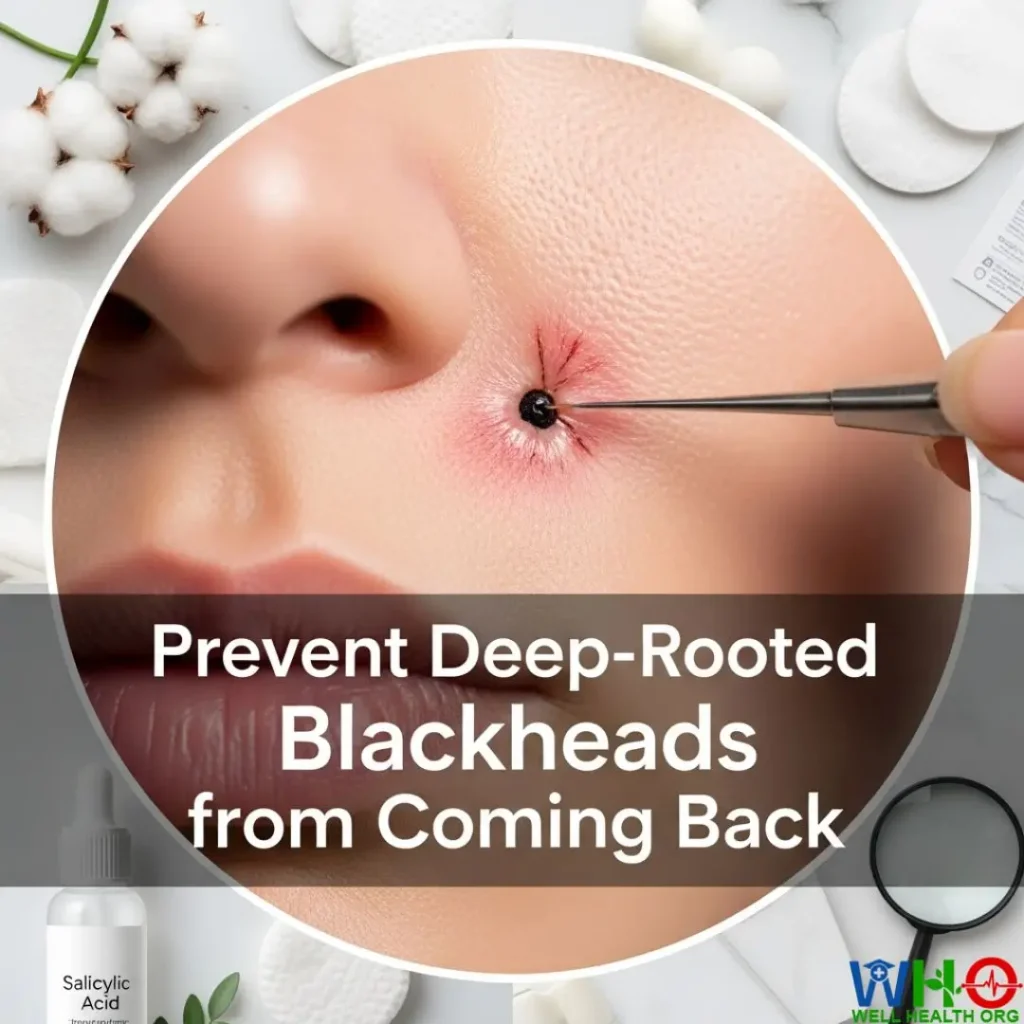Remove Deep-Rooted Blackheads
Blackheads are among the most frustrating skin concerns — small, dark dots that refuse to budge no matter how many times you wash your face. While regular blackheads can often be cleared with basic cleansing or exfoliation, deep-rooted blackheads are a different challenge altogether. These stubborn plugs sit deep within your pores, often requiring more than just surface-level treatments to remove.
- Remove Deep-Rooted Blackheads
- Understanding What Causes Blackheads
- Common Causes of Deep-Rooted Blackheads
- Step-by-Step Guide to Remove Deep-Rooted Blackheads at Home
- Step 1: Start with a Clean Slate
- Step 2: Steam to Open Your Pores Naturally
- Step 3: Exfoliate to Remove Dead Skin and Surface Debris
- Physical Exfoliation
- Chemical Exfoliation
- Step 4: Apply a Clay or Charcoal Mask
- Step 5: Use a Sterilized Extractor Tool (Optional)
- Step 6: Soothe and Protect Your Skin
- What to Avoid During Blackhead Removal
- How to Prevent Deep-Rooted Blackheads from Coming Back
- 1. Follow a Consistent Skincare Routine
- 2. Incorporate Active Ingredients That Work
- Salicylic Acid (BHA)
- Retinoids (Vitamin A Derivatives)
- Niacinamide
- Clay and Charcoal
- Zinc and Tea Tree Oil
- 3. Watch Out for Hidden Pore-Clogging Ingredients
- 4. Maintain a Healthy Lifestyle for Clear Skin
- Hydration
- Balanced Diet
- Stress Management
- Hygiene Habits
- Home Remedies That Actually Work (and the Ones to Skip)
- Safe and Effective Home Remedies
- 1. Honey and Cinnamon Mask
- 2. Green Tea Toner
- 3. Aloe Vera Gel
- 4. Oatmeal Scrub
- Home Remedies to Avoid
- When to See a Dermatologist
- Professional Treatment Options
- 1. Professional Extraction
- 2. Microdermabrasion
- 3. Chemical Peels
- 4. Laser or Light Therapy
- 5. Prescription Topicals
- Common Mistakes That Make Blackheads Worse
- Real-Life Experiences: Clear Skin Transformations
- Your Clear Skin Journey Starts Now
- FAQs About Deep-Rooted Blackheads
Many people make the mistake of squeezing or picking at them, which only leads to inflammation, enlarged pores, and scarring. The truth is, removing deep-rooted blackheads at home safely is absolutely possible — but it requires patience, the right tools, and a little bit of know-how.
In this complete guide, you’ll discover how to remove these deep-seated blackheads effectively and gently, the best at-home techniques dermatologists recommend, the ingredients that truly work, and how to keep your skin clear for good.
Understanding What Causes Blackheads
Before we dive into how to remove deep-rooted blackheads, it’s important to understand why they form in the first place. A blackhead is essentially a clogged pore, but what clogs it is a mix of sebum (skin oil), dead skin cells, and impurities.
Normally, sebum flows freely to the skin’s surface, keeping your skin hydrated and protected. However, when there’s too much oil or dead skin, the mixture forms a plug inside the pore. When this plug is exposed to air, it oxidizes, turning that familiar dark or black color.
Common Causes of Deep-Rooted Blackheads
- Excess Oil Production: Overactive sebaceous glands are one of the biggest culprits.
- Hormonal Changes: Puberty, menstruation, pregnancy, or stress can increase oil production.
- Improper Cleansing: Sleeping with makeup on or skipping face washing lets dirt and oil accumulate.
- Heavy Skincare Products: Creamy or oily formulas can clog pores, especially if they’re not labeled non-comedogenic.
- Environmental Factors: Pollution and humidity can worsen buildup in pores.
- Genetics: Some people are simply more prone to oily skin and blackhead formation.
Unlike surface blackheads that sit near the skin’s opening, deep-rooted blackheads harden inside the pore over time, making them resistant to regular exfoliants or pore strips.
Step-by-Step Guide to Remove Deep-Rooted Blackheads at Home
Successfully removing blackheads without harming your skin requires a calm, methodical approach. Follow these steps carefully, and avoid the temptation to rush the process.

Step 1: Start with a Clean Slate
Always begin with a clean face. Cleansing removes surface impurities that can interfere with your treatment.
- Use a gentle foaming or gel-based cleanser suited to your skin type.
- Avoid harsh soaps or alcohol-based cleansers that strip natural oils.
- Massage the cleanser onto damp skin for about 60 seconds using circular motions.
- Rinse with lukewarm water — hot water can dry out your skin, while cold water can tighten pores prematurely.
If you’ve worn makeup, double-cleanse using a micellar water or oil cleanser before your regular face wash to ensure all residue is gone.
Step 2: Steam to Open Your Pores Naturally
Facial steaming is one of the most effective at-home techniques for loosening hardened sebum. The warm moisture softens debris and makes extraction safer and more efficient.
How to Steam Your Face at Home:
- Boil 4–6 cups of water and pour it into a large, heat-safe bowl.
- Allow it to cool for 1–2 minutes — the steam should feel warm, not scalding.
- Place your face about 6–8 inches above the bowl and drape a towel over your head to trap the steam.
- Steam for 8–10 minutes, taking breaks if it gets too warm.
For an enhanced experience, you can add a few drops of tea tree oil, lavender, or chamomile essential oil to the water. These natural ingredients have antibacterial and calming properties that support clearer skin.
After steaming, pat your skin dry with a clean, soft towel — never rub.
Step 3: Exfoliate to Remove Dead Skin and Surface Debris
Now that your pores are open, it’s time to exfoliate. This removes dead skin cells and helps loosen the plug that’s causing the blackhead.
You can choose between two exfoliation types:
Physical Exfoliation
Use a gentle scrub with fine particles like oatmeal, rice powder, or jojoba beads. Avoid harsh scrubs with large grains (like apricot pits), which can create micro-tears in your skin.
- Apply a small amount to damp skin.
- Massage gently in circular motions for 1–2 minutes.
- Rinse thoroughly with warm water.
Chemical Exfoliation
If you prefer a more advanced and dermatologist-approved method, use an exfoliant with salicylic acid (BHA) or glycolic acid (AHA).
- Salicylic acid penetrates deep into pores, dissolving oil and debris.
- Glycolic acid removes dead cells from the surface, improving texture.
Use once or twice weekly depending on your skin’s tolerance.
Step 4: Apply a Clay or Charcoal Mask
After exfoliation, your pores are more receptive to detoxifying treatments. Clay and charcoal masks are particularly effective because they absorb excess oil and draw out impurities from deep within.
- Kaolin clay is gentle and ideal for sensitive or dry skin.
- Bentonite clay is stronger and suits oily or acne-prone skin.
- Activated charcoal acts like a magnet for dirt and sebum.
Apply a thin, even layer of your chosen mask and let it sit for about 10–15 minutes, or until it’s nearly dry (not completely cracked). Rinse with lukewarm water and pat your face dry.
Pro Tip: Follow this step 2–3 times a week for consistent results.
Step 5: Use a Sterilized Extractor Tool (Optional)
If a few stubborn blackheads remain visible after steaming and masking, you may use an extractor tool. However, this step must be done with extreme care.
Safe Extraction Process:
- Sterilize the tool with rubbing alcohol.
- Position the loop around the blackhead — not directly on top.
- Apply gentle, even pressure to one side and roll it over the pore.
- If the blackhead doesn’t come out easily, stop immediately.
Over-squeezing can cause broken capillaries, bruising, and infection. If a blackhead doesn’t budge, continue with consistent skincare instead of forcing it.
Step 6: Soothe and Protect Your Skin
After extraction, your skin will be more sensitive. Calming it down is crucial to prevent redness, swelling, or irritation.
Apply a soothing serum or mask with ingredients like:
- Aloe vera – cools and hydrates
- Green tea extract – reduces inflammation
- Niacinamide – calms redness and strengthens the skin barrier
- Centella Asiatica (Cica) – speeds up healing
Finish with a light, non-comedogenic moisturizer to seal in hydration.
If you’re performing this routine in the morning, always follow with broad-spectrum SPF 30 or higher, as freshly exfoliated skin is more sun-sensitive.
What to Avoid During Blackhead Removal
There’s a fine line between effective blackhead treatment and damaging your skin. To keep your skin safe, steer clear of the following:
- ❌ Squeezing or picking blackheads with your fingers
- ❌ Using pore strips excessively (they remove surface oil but not deep plugs)
- ❌ Applying toothpaste, lemon, or baking soda (these alter skin pH and cause irritation)
- ❌ Over-exfoliating (more than 3 times per week can strip your barrier)
- ❌ Ignoring aftercare, such as moisturizing and sun protection
Remember: healthy skin is consistent skin, not overworked skin.
How to Prevent Deep-Rooted Blackheads from Coming Back

Getting rid of blackheads is only half the battle — keeping them away is where true skincare discipline comes in. Prevention revolves around consistent cleansing, balanced hydration, and smart product choices. Here’s how to build a routine that keeps your pores clean and clear long-term.
1. Follow a Consistent Skincare Routine
Your daily routine doesn’t have to be complicated, but it should be consistent. Here’s a dermatologist-approved regimen you can follow:
Morning Routine
- Cleanser: Use a gentle, pH-balanced gel cleanser to remove overnight oil buildup.
- Toner (Optional): Choose an alcohol-free toner with witch hazel or rose water to balance oil and tighten pores.
- Serum: Apply one with niacinamide or vitamin C to control sebum and protect against free radicals.
- Moisturizer: Even oily skin needs moisture — pick a lightweight, oil-free moisturizer that won’t clog pores.
- Sunscreen: Always finish with SPF 30 or higher. Sun exposure thickens the outer skin layer, which can trap more debris in pores.
Night Routine
- Double Cleanse: Use a cleansing balm or micellar water followed by your regular cleanser to fully remove makeup and sunscreen.
- Exfoliate: Use a salicylic acid-based exfoliant 2–3 times per week.
- Treatment: Apply a retinoid or serum designed to improve skin turnover and keep pores clear.
- Hydrate: Lock everything in with a lightweight moisturizer or hydrating gel.
Consistency here is key. Regular cleansing and gentle exfoliation prevent the buildup that leads to deep-rooted blackheads.
2. Incorporate Active Ingredients That Work
Not all skincare products are created equal. Focus on proven actives that target the causes of blackheads directly.
Salicylic Acid (BHA)
This oil-soluble acid penetrates deep into pores, dissolving sebum and dead skin cells. It’s especially helpful for blackheads around the nose, chin, and forehead.
Retinoids (Vitamin A Derivatives)
Retinoids speed up cell turnover, which prevents dead cells from clogging pores. Start with a low concentration and use it at night, as it can increase sun sensitivity.
Niacinamide
A form of vitamin B3, niacinamide helps regulate oil production, shrink pore appearance, and strengthen your skin barrier.
Clay and Charcoal
Weekly clay or charcoal masks absorb excess oil and detoxify skin naturally, keeping pores less congested.
Zinc and Tea Tree Oil
Both have antibacterial properties that reduce acne-causing bacteria and calm inflammation.
Adding these actives strategically can make your skin more resistant to blackhead formation over time.
3. Watch Out for Hidden Pore-Clogging Ingredients
Some skincare or cosmetic products contain ingredients that can quietly sabotage your skin. Always check labels for the term “non-comedogenic” (meaning it won’t clog pores).
Avoid these common culprits:
- Heavy oils (like coconut oil or cocoa butter)
- Lanolin
- Mineral oil
- Silicone-heavy primers (unless thoroughly cleansed afterward)
- Alcohol-based toners that dry out the skin
Balanced hydration is crucial — too little moisture causes your skin to produce even more oil as compensation.
4. Maintain a Healthy Lifestyle for Clear Skin
Clear skin isn’t only about what you apply — it’s also about how you live. Your diet, hydration, and stress levels play a huge role in skin health.
Hydration
Drink at least 8–10 glasses of water daily. Hydrated skin regulates oil production better and flushes out toxins.
Balanced Diet
Focus on foods that support skin health:
- Omega-3 fatty acids (from salmon, flaxseeds, walnuts)
- Antioxidant-rich vegetables (spinach, kale, berries)
- Zinc and selenium (found in eggs, pumpkin seeds, and lentils)
Avoid excessive sugar, processed food, and dairy if you notice flare-ups — these can trigger more oil production and inflammation.
Stress Management
Chronic stress raises cortisol levels, which increases sebum production and inflammation. Incorporate stress-relieving habits like meditation, walking, or journaling into your routine.
Hygiene Habits
- Change pillowcases twice weekly.
- Sanitize your phone regularly.
- Avoid touching your face throughout the day.
Small daily choices add up to clearer, more balanced skin over time.
Home Remedies That Actually Work (and the Ones to Skip)
Natural remedies can be helpful — but not all are safe or effective. Let’s separate the real solutions from the myths.

Safe and Effective Home Remedies
1. Honey and Cinnamon Mask
Honey acts as a natural antibacterial and humectant, while cinnamon improves circulation. Mix one tablespoon of raw honey with a pinch of cinnamon powder, apply to the affected area, and rinse after 10–15 minutes.
2. Green Tea Toner
Green tea’s antioxidants help reduce oil production and calm inflammation. Brew strong green tea, let it cool, and apply with a cotton pad after cleansing.
3. Aloe Vera Gel
Pure aloe vera hydrates without clogging pores. Use it daily after cleansing or after extractions to soothe the skin.
4. Oatmeal Scrub
Mix ground oatmeal with a bit of yogurt and honey for a gentle, nourishing exfoliant that removes dead cells without irritation.
Home Remedies to Avoid
Not everything natural is good for your face. Skip these popular but harmful “DIY” tricks:
- Toothpaste: Contains irritating ingredients like menthol and fluoride.
- Lemon juice: Too acidic and can damage your skin’s barrier.
- Baking soda: Alters skin’s natural pH, causing dryness and sensitivity.
- Egg whites: Risk of bacterial contamination and minimal proven benefits.
Stick with proven ingredients and gentle formulations — your skin will thank you.
When to See a Dermatologist
If your deep-rooted blackheads refuse to go away despite consistent care, it might be time to seek professional help. Dermatologists and licensed aestheticians have advanced tools and treatments that go deeper than what you can do at home.
Professional Treatment Options
1. Professional Extraction
Performed by an expert under sterile conditions, professional extraction clears pores without damaging skin or causing scarring.
2. Microdermabrasion
This non-invasive procedure uses a diamond-tipped device to exfoliate dead skin and remove buildup, improving texture and radiance.
3. Chemical Peels
Chemical peels with glycolic or salicylic acid dissolve debris deep inside pores, stimulate collagen, and even out skin tone.
4. Laser or Light Therapy
These treatments target bacteria and regulate oil glands, helping prevent future blackheads and acne breakouts.
5. Prescription Topicals
Dermatologists can prescribe stronger retinoids or antibiotic creams for persistent blackheads and acne.
Professional guidance ensures you treat the root cause effectively, especially if your skin is reactive or prone to scarring.
Common Mistakes That Make Blackheads Worse
Even with good intentions, some habits can sabotage your efforts:
- Over-washing your face: Stripping your skin too often increases oil production.
- Skipping moisturizer: Dehydrated skin produces more oil to compensate.
- Ignoring SPF: UV damage thickens the outer layer of skin, trapping debris.
- Using multiple actives at once: Combining acids, retinoids, and scrubs can over-exfoliate your skin barrier.
Simplify your skincare — fewer, targeted products often work better than layering too many.
Real-Life Experiences: Clear Skin Transformations
- Amelia, 27, battled stubborn blackheads on her nose and chin for years. After committing to a salicylic acid exfoliant and weekly clay masks, she saw her pores clear up within eight weeks.
- David, 32, had deep blackheads around his forehead from heavy workout sweat. Switching to a gel cleanser and using a retinoid at night transformed his skin in under three months.
- Lara, 41, with sensitive skin, relied on steaming and aloe vera to gently manage her pores without irritation — her skin became smoother and brighter over time.
Consistency, patience, and smart product choices are what truly make the difference.
Your Clear Skin Journey Starts Now
Removing deep-rooted blackheads at home isn’t about harsh scrubbing or quick fixes — it’s about working with your skin, not against it. The combination of gentle cleansing, consistent exfoliation, targeted treatments, and smart prevention habits can transform your complexion over time.
Remember:
- Be gentle with your skin — never force extractions.
- Consistency beats intensity — a steady routine works best.
- Protect your progress — always moisturize and wear SPF.
With the right care and patience, clear, radiant, blackhead-free skin is absolutely achievable.
FAQs About Deep-Rooted Blackheads
1. Can I remove deep blackheads overnight?
No — deep blackheads require consistent care over several weeks. Quick fixes can damage your skin and make pores appear larger.
2. How often should I steam my face?
Once or twice a week is ideal. Over-steaming can dry your skin and increase oil production.
3. Are blackheads the same as acne?
Blackheads are a mild form of acne called open comedones. Unlike pimples, they aren’t inflamed or pus-filled.
4. What’s the best ingredient for preventing blackheads?
Salicylic acid and retinoids are the most effective for keeping pores clear.
5. Should I moisturize even if my skin is oily?
Absolutely. Oil-free, non-comedogenic moisturizers help balance your skin and prevent rebound oiliness.







